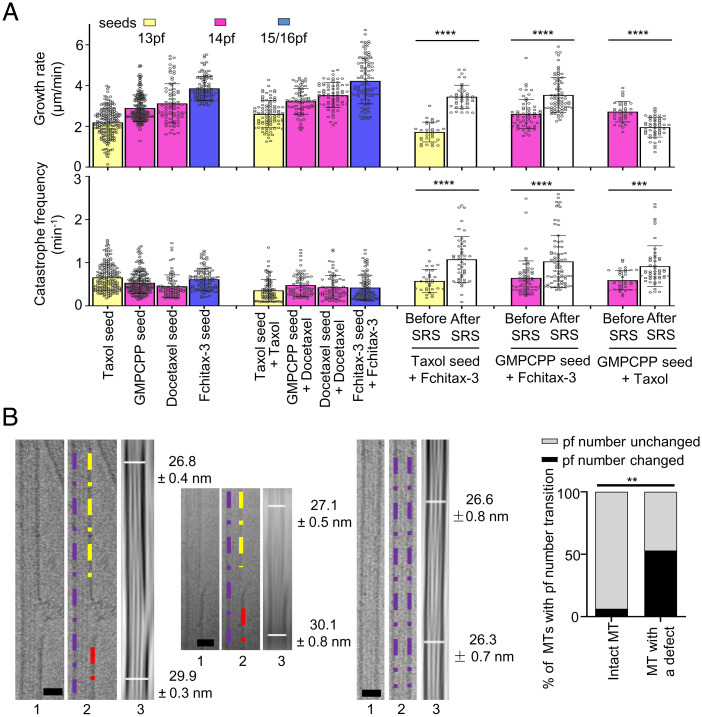Fig. 4.
Lattice defects observed in mismatching conditions are associated with switching of protofilament number. (A) Quantification of growth rates (Upper) and catastrophe frequencies (Lower; calculated as the frequency of all growth perturbations including catching-up events) for the indicated conditions. For better comparison, data from Fig. 1D are presented again in the present panels; n = 193, 196, 82, and 104 microtubule growth events for microtubules polymerized from Taxol, GMPCPP, docetaxel, and Fchitax-3 seeds; n = 91, 70, 71, and 100 in the presence of Taxol seed + Taxol (100 nM), GMPCPP seed + docetaxel (100 nM), docetaxel seed + docetaxel (100 nM), and Fchitax-3 seed + Fchitax-3 (100 nM); n = 30 and 40 for Taxol seed + Fchitax-3 (100 nM) before and after SRS formation; n = 60 and 75 for GMPCPP seed + Fchitax-3 (100 nM) before and after SRS formation; n = 35 and 51 for GMPCPP seed + Taxol (100 nM) before and after SRS formation; n = 3 independent experiments. Error bars represent SD. The colors of the bars and protofilament values indicate the protofilament number preferences of a particular drug used. ***P < 0.001, ****P < 0.0001, Mann–Whitney U test. (B) Representative raw cryo-EM images and their filtered versions with enhanced microtubule Moiré patterns showing the diameter difference (protofilament number transition) for microtubules grown from GMPCPP seeds in the presence of Fchitax-3 (mismatching condition; Fig. 3A). For each panel, Left and Central show defect-containing microtubules and Right shows a microtubule with no visible defects. (Scale bars, 25 nm.) Images 1 and 2 are raw cryo-EM images, with purple, yellow, and red dashed lines highlighting diameter differences on either side of a defect in image 2. Image 3 shows the diameters for two ends of a microtubule. Diameters were measured in Fiji. Percentage of microtubules with protofilament number transition in microtubules with no visible defects (n = 19) and microtubules with sheet-like defects (n = 17). The percentage differences were evaluated by two-sided Fisher’s exact test; **P = 0.0023.

